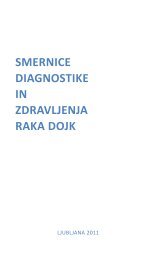You also want an ePaper? Increase the reach of your titles
YUMPU automatically turns print PDFs into web optimized ePapers that Google loves.
Clinical relevance and tumor biological role of the<br />
urokinase receptor mRNA splice variant uPAR-del4/5<br />
Sumito Sato 1 , Matthias Kotzsch 2 , Thomas Luther 2 , Paul N. Span 3 ,<br />
and Viktor Magdolen 1<br />
1<br />
Clinical Research Unit, Department of Obstetrics and Gynecology, Technical University<br />
München, D-81675 München, Germany; 2 Institute of Pathology; 3 Department of Chemical<br />
Endocrinology, Radboud University Nijmegen Medical Centre, NL-6500 HB Nijmegen,<br />
The Netherlands<br />
Strong clinical and experimental evidence has accumulated that interaction of<br />
the urokinase-type plasminogen activator (uPA) with its three-domain receptor<br />
(uPAR, CD87) facilitates extravasation and intravasation of tumor cells.<br />
Several splice variants of uPAR, which is encoded by 7 exons, have been reported,<br />
including uPAR-del4/5 lacking exons 4 and 5. This variant encodes a uPAR form in<br />
which domain DII of uPAR is missing. Analysis of uPAR-del4/5 mRNA expression<br />
revealed that this variant is predominantly expressed in tumor cells. Furthermore,<br />
elevated uPAR-del4/5-expression is significantly associated with shorter disease-free<br />
survival of breast cancer patients (Luther et al. 2003, Thromb Haemost 89: 705-17;<br />
Kotzsch et al. 2005, Eur J Cancer 41: 2760-8).<br />
For analysis of the tumor biological role of this uPAR variant, expression plasmids<br />
encoding the splice variant uPAR-del4/5 were generated and stably transfected into<br />
a series of breast cancer cell lines (MDA-MB-231, CAMA-1, MCF-7, and ZR-75) and<br />
into an ovarian cancer cell line (OV-MZ-6).<br />
The transfected cells were analyzed for expression of uPAR-del4/5 using uPAR ELISA,<br />
and showed a 5-10 fold increased expression of uPAR-del4/5 as compared to the<br />
106p33<br />
vector-transfected cells. The cells displayed no significant difference with respect to<br />
morphology and proliferation. The stably transfected cell lines have been analyzed<br />
in Matrigel invasion and in adhesion assays. Interestingly, the results demonstrate<br />
that the tumor cell lines overexpressing uPAR-del4/5 exhibit a significant decrease<br />
of invasion through Matrigel as well as a significant decrease of adhesion to several<br />
ECM component proteins in comparison to the vector-transfected control cells.<br />
Subsequently to the investigations of the characteristics of uPAR-del4/5 in in vitro<br />
analysis, animal experiments will be performed to test whether differences observed<br />
in vitro lead to an effect in tumor growth and metastasis. Furthermore, comparison<br />
of the gene expression pattern in uPAR-del4/5 overexpressing cells versus vector<br />
transfected cells may give new insights into the tumorbiological role of uPAR-del4/5<br />
and represent new candidate genes for prognostic markers in breast cancer.

















